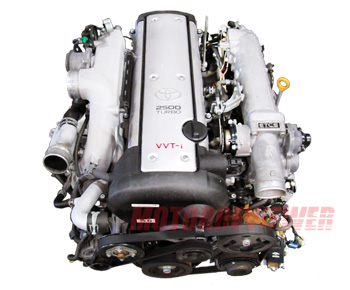Toyota 1JZ-GTE/GE/FSE Engine Specs, Problems & Reliability

Toyota's 1JZ is a 2.5-liter straight-six naturally aspirated or turbocharged gasoline engine out of JZ family which also includes 3.0-liter version - 2JZ engine. The 1JZ series was produced from 1990 to 2007 and used in rear-wheel-drive Toyota's models such as Toyota Supra, Toyota Mark II, Toyota Crown, Toyota Soarer, and etc. The engine became popular thanks to a turbocharged version (1JZ-GTE) as well as incredible reliability and potential for tuning. But the most widespread 1JZ engine is the 1JZ-GE - 2.5L naturally aspirated version.
All 1JZs have a cast iron cylinder block, aluminum cylinder head with four valves per cylinder (24 valves total) and solid shimless buckets (no hydraulic lifters), double overhead camshafts driven by a toothed timing belt, and two-stage variable length intake manifold (Toyota's ACIS). Later 1JZ-GE engines had an ignition system with distributor and 10:1 compression ratio. After updating in 1995, they were equipped with DIS-3 distributorless ignition and variable valve timing technology VVT-i for the intake only. 1JZ-GE VVT-i engines have a 10.5:1 compression ratio. As you can see, the most common 1JZ version is a straight forward six-cylinder engine with a minimum of expensive and unreliable electronic components.
The 1JZ-GTE engine is a high-performance version used in sporty models. The first generation 1JZ twin turbo was equipped with two CT12A turbochargers producing together a 10 psi (0.7 bar) of boost pressure. The 1JZ-GTE Gen 1 has forged connecting rods and pistons lowering compression ratio to 8.5:1. The fuel system got 380 cc injectors. 1JZ-GTE camshaft specifications: duration - 224/228 deg (intake/exhaust), valve lift 7.69/7.95 mm (intake/exhaust).
Like the 1JZ-GE, the 1JZ-GTE went through some changes in 1996. This second-gen turbo 1JZ has Toyota's BEAMS architecture. The biggest one is the replacement of two turbochargers with a single CT-15B turbocharger. Toyota's engineers also added the VVT-i system for the intake and increased the compression ratio to 9.0:1. A new cylinder head has smaller exhaust ports and modified water jackets for efficient cooling. New modified turbo engines produce the same power, but the max torque was increased by 15 lb-ft (20 Nm) and more noticeable, have 50% torque increase low engine speeds.
In 2000, Toyota introduced the 1JZ-FSE - a 2.5-liter inline six-cylinder direct-injected gasoline engine. The 1JZ-FSE engine had an engine block from the 1JZ-GE and unique cylinder head design implementing Toyota's direct injection system D-4. FSE engines have 11.0:1 compression ratio and always came with VVT-i.
Engine Specs
Direct injection
SAE 10W-30 Synthetic Motor Oil - turbo engines
1JZ Engine Problems and Reliability
1JZ engines are very reliable and there are no significant problems with proper care. Also, they are considered as ideal workpieces for various modifications and tuning. Let's highlight a few common problems happening with the 1JZ series.
First of all, the 1JZ water pump is a very short-lived part. The engine is afraid of moisture and wet washing. Those yearly's VVT-i systems are not as good and reliable as nowadays. Broken VVT-i causes rough idle, a misfire, and produces strange knocking sounds from the cylinder head. Another reason for a misfire is often failed ignition coils of the DIS-3 ignition. The 1JZ-GTE Gen 1 features turbochargers with ceramic turbine wheels, which are prone to delamination and failure under high temperature and boost. In general, the first generation of turbocharged 1JZ is more prone to turbo failure. 1JZ engines consume a lot of oil, especially if the mileage is far beyond a couple of hundred thousand miles, which is not uncommon.
The most durable and reliable 1JZ is a simple non-VVT-i 1JZ-GE engine. The longevity is well over 200,000 miles (320,000 km), but they are old now and find one of these engines in a good shape is not an easy task.
Modifications
1JZ-GE (1990-1995) - 170 hp (125 kW) at 6,000 rpm, 173 lb-ft (235 Nm) at 4,800 rpm.
1JZ-GE VVT-i (1995-2007) - 200 hp (147 kW) at 6,000 rpm, 185 lb-ft (251 Nm) at 4,000 rpm.
1JZ-GTE (1990-1996) - 280 hp (206 kW) at 6,200 rpm, 268 lb-ft (363 Nm) at 4,800 rpm.
1JZ-GTE VVT-i (1996-2007) - 280 hp (206 kW) at 6,200 rpm, 280 lb-ft (379 Nm) at 2,400 rpm.
1JZ-FSE (2000-2007) - 200 hp (147 kW) at 6,000 rpm, 184 lb-ft (250 Nm) at 3,800 rpm.
